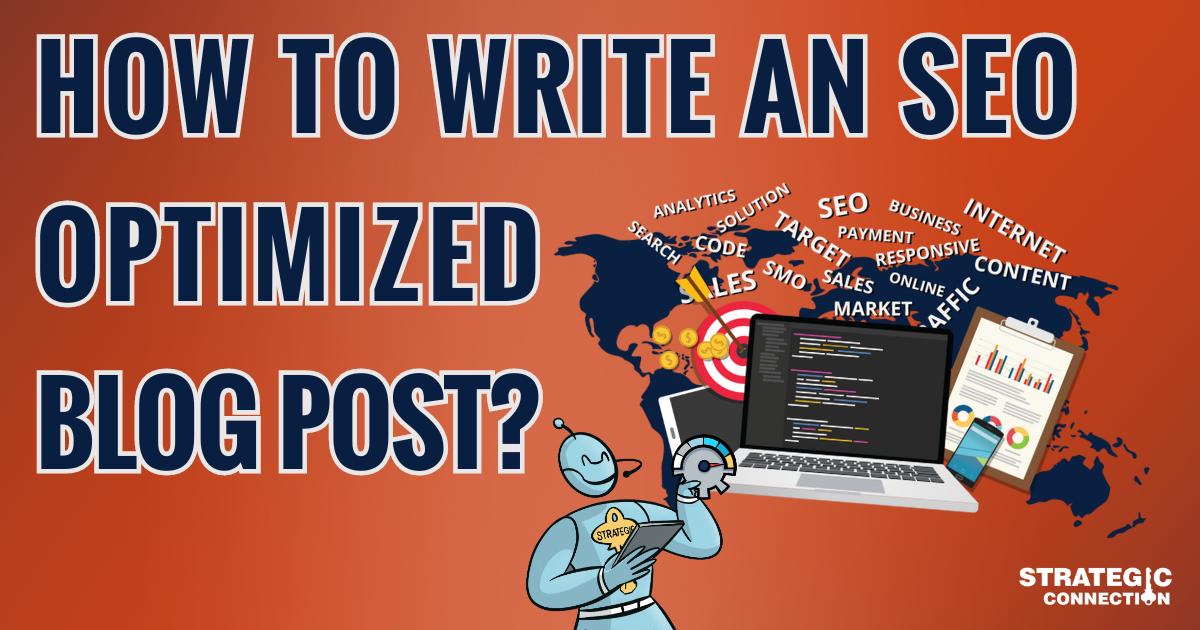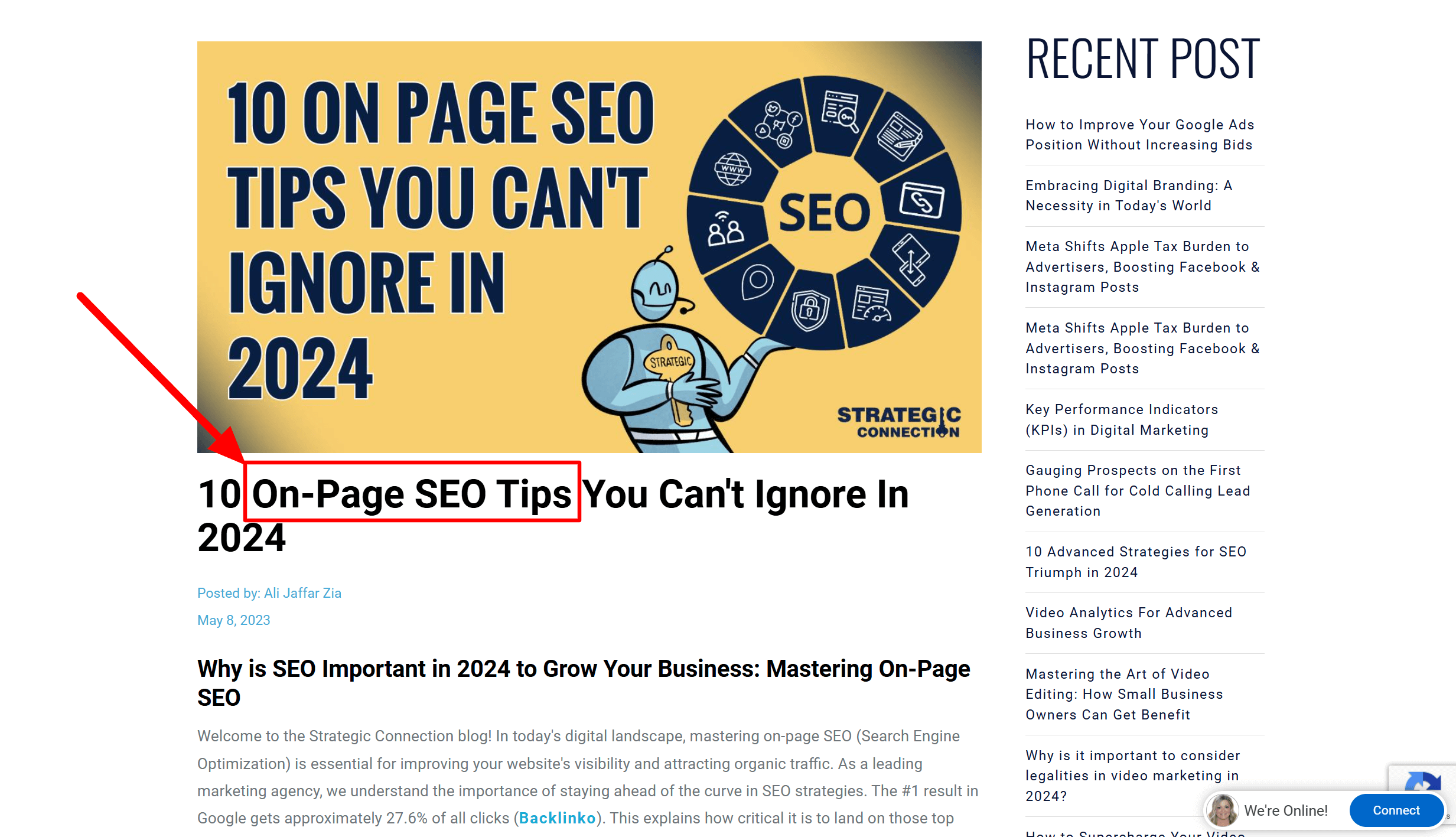
How to Write an SEO-Optimized Blog Post
Posted by: Ali Jaffar Zia
July 17, 2024
In today’s competitive digital landscape, knowing how to write an SEO-optimized blog is crucial for driving organic traffic and enhancing online visibility. This guide will walk you through the essential steps to create an SEO-optimized
blog that not only ranks high but also engages and converts your audience.
A blog is a critical element of your marketing strategy. When done right, it educates your target audience on your products and services and becomes a lead-generating engine.

This blog will help you learn how to write a search engine-optimized article for your website in detail.
Follow the steps, and let’s start!
1. Conduct Thorough Keyword Research
The foundation of an SEO-optimized blog starts with robust keyword research. Identifying the right keywords helps you target the terms your audience is searching for.

- Primary Keywords: Use tools like Google Keyword Planner, Ahrefs, or SEMrush to find relevant keywords with a high search volume and moderate competition. According to Ahrefs, 90.63% of pages get no organic search traffic
from Google, highlighting the importance of effective keyword research.
- Secondary Keywords: Look for long-tail keywords and related phrases to include naturally in your content. Long-tail keywords make up 70% of all web searches, making them a valuable part of your strategy.
- Competitor Analysis: Study the top-ranking articles for your chosen keywords to understand their strategies. Tools like SEMrush allow you to analyze competitor content and see what keywords they rank for.
2. Craft a Compelling and Keyword-Rich Title
Your blog title is the first thing readers and search engines see. For an SEO-optimized blog, ensure your title is engaging and includes your primary keyword.
- Include the Focus Keyword: Make sure your primary keyword, "SEO optimized blog," is part of the title.

- Engagement Factor: Use numbers, questions, or power words to make your title more appealing. Titles with numbers can increase CTR by 36%.
- Length Matters: Keep your title under 60 characters to avoid truncation in search engine results.
3. Structure Your Content with Headings and Subheadings
Proper content structure is essential for readability and SEO. Headings and subheadings help break up your content and signal the importance of each section to search engines.
- H1 for Title: Use an H1 tag for your main title. According to Moz, this is a significant on-page SEO factor.

Here’s an example of how H1 and H2 Headers are structured on a sample blog.
- Descriptive Subheadings: Use H2 and H3 tags for subheadings, ensuring they are descriptive and include keywords where appropriate. Clear subheadings can improve user experience, with 43% of people skimming blog posts
by reading the subheadings first.
- Include Keywords: Naturally incorporate the focus keyword, "SEO optimized blog," in at least one subheading.
4. Write High-Quality, Valuable Content
Content is king in SEO. An SEO-optimized blog should provide value, be well-researched, and engage the reader. Let's go deeper into what these terms mean.
- Value-Driven Content: Ensure your blog is informative and answers your audience's questions. High-quality content can lead to a 2x increase in traffic over time.
- Natural Keyword Usage: Use your keywords naturally and avoid keyword stuffing. Aim to include an "SEO optimized blog" at least ten times throughout the content. Backlinko states the ideal keyword density is around 1-2%.
- Optimal Length: Longer content tends to rank better. Aim for 700 to 1000 words to cover the topic comprehensively. HubSpot reports that the ideal blog post length for SEO is between 2,100 and 2,400 words, but shorter
posts can still be effective if they are informative and well-structured.
According to SERP IQ, here are the numbers
for your top 10 ranked blog posts.

5. Optimize Images and Media
Images enhance engagement and can boost SEO if used correctly. An SEO-optimized blog should include optimized images.
The more images, the more entertaining and objective the blog appears to be.
Who doesn't like a few extra images to tell the story better?
Here are some good tips to optimize your images.
- Relevant Images: Use high-quality images to break up text and enhance visual appeal. Content with relevant images gets 94% more views than content without images.
- Optimized File Names: Include keywords in your image file names. This helps search engines understand what the images are about.
- Alt Text: Use descriptive alt text for images, incorporating keywords like "SEO optimized blog" where appropriate. Alt text is crucial for accessibility and can improve image search rankings.
6. Use Internal and External Links
Links are vital for SEO. They help build authority and provide value to readers by directing them to additional resources.
For optimal SEO, a blog's number of internal and external links should be balanced and relevant. Aiming for 2-5 internal links for every 500 words is a good practice, which means a 1000-word blog post would ideally have 4-10 internal
links.

These links should direct readers to high-quality, related content within your website to enhance their understanding of the topic. Aim for 1-3 per 500 words for external links so that a 1000-word post would have 2-6 external links.
These links should point to reputable sources that add value and credibility to your content. Ensuring internal and external links are relevant and useful to the reader is key to improving SEO and providing a better user experience.
- Internal Links: Link to other relevant posts on your site to keep readers engaged and improve site structure. Internal linking can boost pageviews by up to 10%.
- Optimized File Names: Include keywords in your image file names. This helps search engines understand what the images are about.
- External Links: Link to authoritative sources to add credibility to your blog. External links to high-authority sites can improve your blog’s trustworthiness and SEO.
7. Make Sure You Have Topical Authority
It's no longer just about the keyword. It's about how well your article meets the needs of the topic you're writing on. Additionally, consider whether your article is an authority on the subject. Make sure to use different synonyms
of your focus keyword throughout your blog and cover various subsets of your topic to ensure you address all relevant details.
What Is Topical Authority in SEO & How to Build It (ahrefs.com)
Moreover, engaging with your audience by providing valuable insights and actionable advice can significantly enhance your article's impact. Incorporating credible sources and up-to-date information will further establish your content's
authority. Remember, a well-rounded, informative article not only attracts readers but also builds trust and credibility in your expertise
Best SEO Tools to Use in 2024
The right SEO tools can significantly enhance your SEO efforts and help you create a truly SEO-optimized blog. Here are the top five tools for 2024:
- Ahrefs:
Ahrefs is a comprehensive SEO toolset that helps with keyword research, backlink analysis, and competitor research. It provides insights into your competitors'
actions and how you can improve your SEO strategy. Ahrefs' Site Explorer feature is particularly useful for identifying the keywords your competitors rank for.
- SEMrush:
SEMrush is an all-in-one marketing toolkit that offers SEO, PPC, content, social media, and competitive research. It helps you track your website’s performance, conduct
site audits, and uncover new keyword opportunities. SEMrush's Keyword Magic Tool is excellent for finding long-tail keywords.
- Google Analytics:
Google Analytics is essential for tracking and analyzing website traffic. It provides detailed insights into user behavior, traffic sources, and conversion rates, helping you understand how your
SEO efforts are performing. Google Analytics can also help you identify which content resonates with your audience.
- Moz Pro:
Moz Pro offers SEO tools to help with keyword research, link building, site audits, and page optimization. Moz's Keyword Explorer is particularly
useful for discovering high-potential keywords and understanding search volume and difficulty.
- Yoast SEO:
Yoast SEO is a popular WordPress plugin that helps optimize your content for search engines. It provides real-time feedback on your content’s SEO performance,
including keyword usage, readability, and meta tags. Yoast SEO also helps with technical SEO aspects like XML sitemaps and schema markup.
Monitor and Update SEO Regularly
SEO is not a one-time effort but a continuous process. Monitoring SEO is crucial for several reasons. It helps track the effectiveness of your SEO strategies, ensuring that your efforts lead to improved search engine rankings.
You can identify what is working and what needs adjustment by monitoring key metrics such as organic traffic, keyword rankings, and bounce rates. Additionally, SEO monitoring allows you to stay ahead of algorithm updates and industry
changes. Search engines frequently update their algorithms; staying informed about these changes helps you adapt your strategies accordingly.

It also provides insights into your competitors' performance, enabling you to adjust your tactics to stay competitive. Regular monitoring helps identify and fix technical issues such as broken links, slow page load times, and mobile
usability problems, which can negatively impact your website's performance and user experience. Continuous SEO monitoring is essential to maintain and improve your website's visibility, traffic, and overall success.
Performance Tracking: Use tools like Google Analytics and Search Console to track your blog’s performance. According to a HubSpot survey, businesses
that track their metrics are 2.8 times more likely to achieve their marketing goals.
Content Updates: To keep your content current, regularly refresh it with new information, keywords, and insights. Updating old blog posts with new data and information can increase organic traffic by as much as 111%.
Final Remarks
Writing an SEO-optimized blog involves strategic planning and execution. You can create blog posts that rank high on search engines and resonate with your audience by conducting thorough keyword research, crafting compelling titles,
structuring content effectively, and continuously monitoring performance. Remember, an SEO-optimised blog aims to provide value while enhancing your online visibility.
More Related Blogs:
Also read these related blogs for more useful information.








